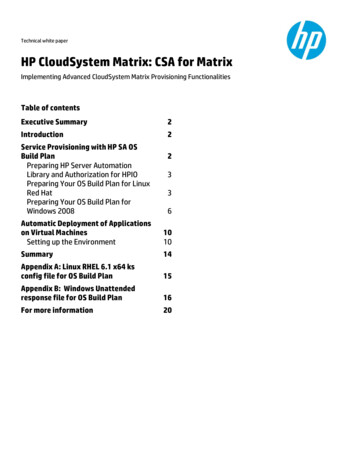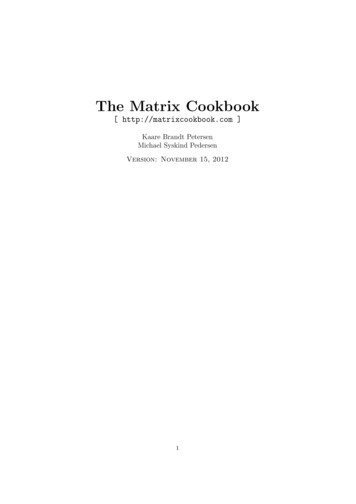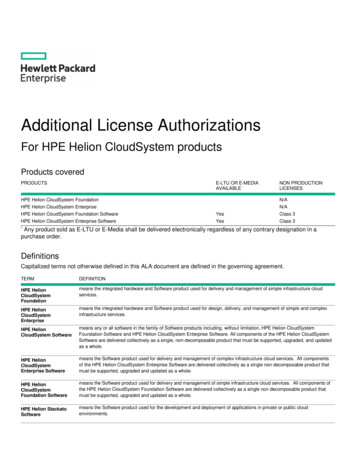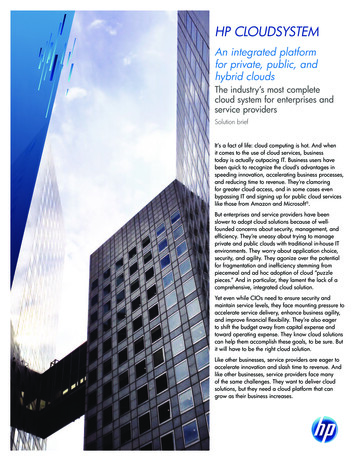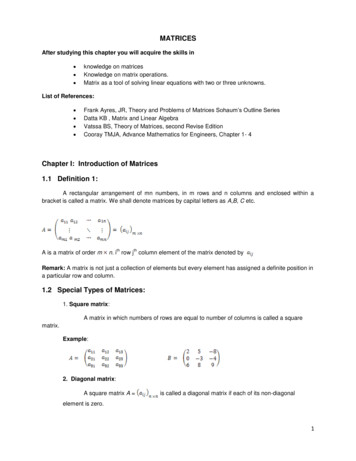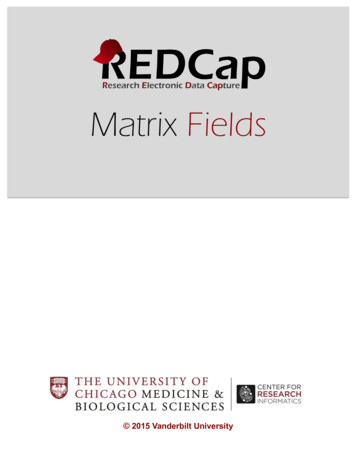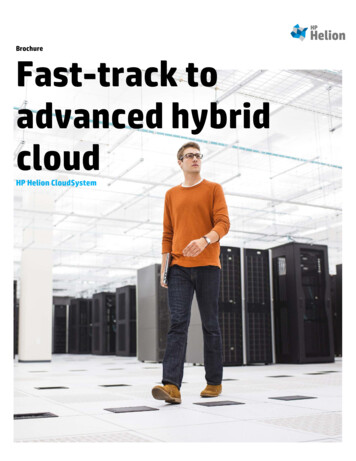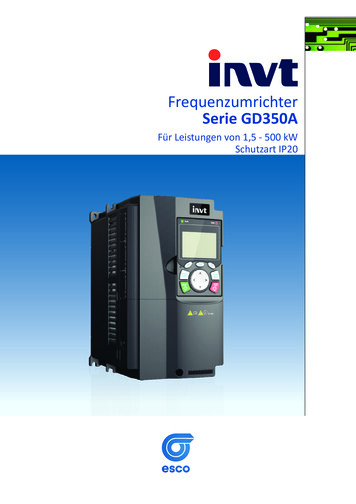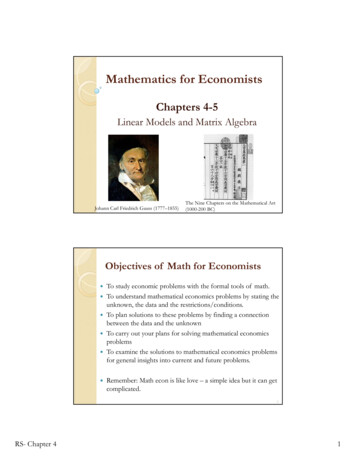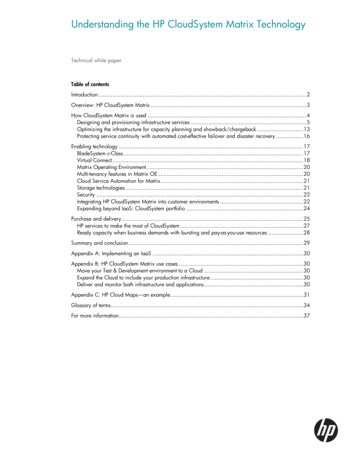
Transcription
Understanding the HP CloudSystem Matrix TechnologyTechnical white paperTable of contentsIntroduction.2Overview: HP CloudSystem Matrix .3How CloudSystem Matrix is used .4Designing and provisioning infrastructure services .5Optimizing the infrastructure for capacity planning and showback/chargeback .13Protecting service continuity with automated cost-effective failover and disaster recovery .16Enabling technology .17BladeSystem c-Class .17Virtual Connect.18Matrix Operating Environment.20Multi-tenancy features in Matrix OE.20Cloud Service Automation for Matrix.21Storage technologies .21Security .22Integrating HP CloudSystem Matrix into customer environments .22Expanding beyond IaaS: CloudSystem portfolio .24Purchase and delivery .25HP services to make the most of CloudSystem.27Ready capacity when business demands with bursting and pay-as-you-use resources .28Summary and conclusion.29Appendix A: Implementing an IaaS .30Appendix B: HP CloudSystem Matrix use cases.30Move your Test & Development environment to a Cloud .30Expand the Cloud to include your production infrastructure .30Deliver and monitor both infrastructure and applications.30Appendix C: HP Cloud Maps—an example.31Glossary of terms.34For more information.37
IntroductionBusinesses are moving to the cloud in accelerating numbers. Business users recognize cloud advantages that helpspeed innovation, accelerate business processes, and reduce time to revenue. Frequently, these users turn to publiccloud services for the solutions they need. In fact, a Forrester study found that business is adopting cloud 2.5 timesfaster than is IT operations. 1 IT directors, faced with the challenges associated with the rush to cloud-based services,are concerned: how can IT maintain adequate security, ensure service levels, integrate cloud-based services withexisting traditional IT systems, and provide governance across the entire IT value chain? In addition, IT directors wantto be sure that the decisions they make today about cloud technology suppliers don’t prevent them from innovating inthe future.At the same time, IT departments are under tremendous pressure to keep pace with business demand. While ITinfrastructure has made significant advances in performance and availability, the effort to meet increasing businessdemands has frequently led to “IT sprawl.” Computing resources proliferate, but remain underutilized and toohardwired to redeploy easily when business needs change. IT increasingly employs virtualization and automation toimprove the flexibility and increase utilization of computing resources. However, this course has not yet eliminated theissues of over-provisioning and complexity. Too frequently, IT resources are dedicated to a particular application orbusiness unit and any excess capacity remains unavailable for other uses. IT continues to be hampered in its ability tofocus its resources on strategic objectives and driving innovation, resulting in slow time to revenue and lostopportunity.IT departments are evolving from the role of sole supplier to becoming both builder and broker of IT services. As such,IT must build its capability as an internal service provider that matches the transparency and flexibility of externallyavailable services, as well as be able to source and consume services from a network of trusted suppliers.HP offers you a path to providing secure, predictable cloud-based services through Converged Infrastructure. Your ITstaff can consolidate physical and virtual server, storage, and network assets into pools of virtualized resources.These resource pools can host sets of infrastructure services, which typically map to application services, includingcomplex multitier, multi-node applications. IT personnel can flexibly provision and re-provision services, and canconfidently optimize the underlying resources for performance, resiliency, and efficiency.HP Converged Infrastructure technologies are at the core of the HP CloudSystem portfolio: a comprehensive,integrated, and open solution that provides IT with a unified way to provision and manage services across private,managed, and public clouds. HP CloudSystem equips you to respond to customers or business units faster, morepredictably, more efficiently, and with lowered costs. HP CloudSystem offerings provide a range of services as wellas an avenue for growth and expansion. As shown in Figure 1, HP CloudSystem has three integrated offerings. HP CloudSystem Matrix: Enables you to deliver infrastructure as a service (IaaS) and provisions infrastructure andbasic applications in minutes. HP CloudSystem Enterprise: For those looking to deploy private and hybrid cloud environments and the full rangeof service models (IaaS, platform as a service (PaaS), and software as a service (SaaS). This offering provides asingle service view of your environments, from private cloud to public clouds to traditional IT, with advancedapplication-to-infrastructure lifecycle management. HP CloudSystem Service Provider: Public or hosted private cloud designed for service providers to provide a publiccloud IaaS and SaaS, including aggregation and management of those services.12Forrester Research, Inc., Ignoring Cloud Risks A Growing Gap Between I&O And The Business, March 24, 2011
Figure 1: Three integrated HP CloudSystem offerings for a full range of cloud capabilitiesThis whitepaper describes the HP CloudSystem Matrix solution, with a focus on how it delivers IaaS. The document isintended for IT directors, IT architects, solution architects, and other readers who are familiar with current HPBladeSystem offerings and existing server virtualization technology. The content should assist you in understandinghow HP CloudSystem Matrix can benefit your IT environments with more flexible, efficient use of physical and virtualIT resources. The paper begins with a discussion of key architectural and operational concepts and then highlights thekey enabling technologies; it concludes with a brief overview of the purchase and implementation process, includingavailable services.Overview: HP CloudSystem MatrixHP CloudSystem Matrix is an IaaS solution for private and hybrid cloud deployments, built on proven HP ConvergedInfrastructure technologies, such as HP BladeSystem, Matrix Operating Environment and Cloud Service Automationfor Matrix. HP CloudSystem Matrix allows you to: Provision infrastructure and applications in minutes for physical and virtual environments. Reduce TCO up to 56% 2 with built-in infrastructure life-cycle management. Integrate heterogeneous environments into your IaaS infrastructure.HP Cloud Maps accelerate automation of cloud service deployments and ensure consistency and reliability of theimplementation of infrastructure service catalogs.CloudSystem Matrix is an integrated hardware, software, and services solution that helps you realize the full value ofcloud computing as quickly as possible. The core elements of a CloudSystem Matrix solution are: HP BladeSystem c7000 enclosures (one or more) HP Virtual Connect HP Matrix Operating Environment HP Cloud Service Automation (CSA) for Matrix HP Implementation Service2Compared to traditional infrastructure, based on analysis with the BladeSystem and BladeSystem TCO calculators:http://www.hp.com/go/matrixtco3
HP CloudSystem Matrix is optimized for HP ProLiant and HP Integrity servers as well as HP storage and HPnetworking, but also supports 3rd party x86 servers, networking, and storage. Supported operating systems areWindows , Linux and HP-UX. Supported hypervisors include VMware, Microsoft Hyper-V, and Integrity VMs.The Matrix Operating Environment includes an integrated service designer, self-service infrastructure portal, and autoprovisioning capabilities. It includes the tools to manage and optimize resource pools, multi-tenancy, and a recoverymanagement solution for ProLiant. Recovery management for HP-UX is available with HP Serviceguard. Usingincluded Cloud APIs, you can easily customize the operating environment to your specific requirements, enablingchargeback and billing integration, integration into approval processes, and other process automation tasks. CSA forMatrix integrates basic application provisioning, monitoring, and patch and change management. And because it isvital to get started down the right path, CloudSystem Matrix also includes a comprehensive Implementation Service.This service is performed by HP trained experts, including a project manager to manage the technical preplanning,installation, configuration, testing, demonstration, and orientation of your integrated Matrix package solutions.There is also an upgrade path for future HP BladeSystem purchases as IT needs grow, all while protecting the existingHP BladeSystem investment. The HP CloudSystem Matrix Conversion Services provide a cost-effective way to startrealizing the benefits of shared services and a private cloud today. CloudSystem Matrix is available as a small,medium, or large configuration, which can be expanded with additional hardware and software from HP or thirdparties.Figure 2 provides a diagram of the HP CloudSystem Matrix solution with Virtual Connect FlexFabric.Figure 2: Solution diagram of HP CloudSystem Matrix with Virtual Connect FlexFabric module** Optionally, Virtual Connect Flex-10 modules can be used for LAN connection and Virtual Connect Fibre Channel Modules for SAN connection.** Cloud Service Automation for Matrix is an optional component of the CloudSystem Matrix solution.How CloudSystem Matrix is usedPerhaps the best way to understand the unique value of the solution is to examine how you can build a private andhybrid cloud, and deliver and operate infrastructure services, using HP CloudSystem Matrix and the capabilities ofthe Matrix Operating Environment and CSA for Matrix (illustrated conceptually in Figure 3).4
Figure 3: CloudSystem Matrix automates the entire lifecycle to build and manage a private and hybrid cloudThe Matrix Operating Environment enables provisioning and re-provisioning of the shared pools of servers, storage,power, and network connectivity as needed, based on pre-defined templates. Typically, each template represents thecomplete infrastructure needed to host a specific application service, such as Microsoft Exchange, Oracle RealApplication Clusters (RAC), an enterprise resource planning solution, or even a custom application, and may includethe application itself. An IT architect uses a graphical designer tool to build and publish these infrastructure servicetemplates. Using a self-service infrastructure portal, IT users can view a catalog of published service templates andrequest an instance of a service to be automatically provisioned. Through its infrastructure orchestration and coremulti-tenancy capabilities, Matrix provides standardization, resource sharing across client organizations, and efficientprovisioning control for a private/hybrid cloud infrastructure.Compared to a manual process that requires coordination among different teams across a data center or ITorganization, CloudSystem Matrix enables administrators to provision an entire infrastructure service, including theapplication, in just minutes or hours instead of weeks or months. Administrators can also continuously monitor andoptimize the cloud infrastructure—for example, by managing capacity, moving workloads or adjusting infrastructureservice lease periods—as well as protect service continuity with disaster recovery and automated server failover.Advanced capabilities enable an IT administrator to provision services outside of the private cloud managed byMatrix by “bursting” into a public cloud to provision template-defined services as needed. The following sectionsdescribe in further detail how CloudSystem Matrix enables provisioning, optimizing, and protecting continuity ofcloud infrastructure services. (For definitions of many of the terms used here, see the Glossary of terms.)Designing and provisioning infrastructure servicesThe most powerful attribute of HP CloudSystem Matrix is the speed and simplicity with which pools of infrastructureresources can be “carved up” and flexibly configured and reconfigured to match the infrastructure requirements ofnearly any application. You can deploy a single CloudSystem Matrix environment in place of multiple different serverconfigurations to satisfy varied application requirements for CPU, memory, network, and storage and quickly buildyour private cloud. Matrix resources are then available on demand as infrastructure services for IT users to requestusing a service catalog.In a traditional IT environment, the deployment of a new application requires the involvement of many people and ahigh degree of coordination among them. An IT architect might draw up a design specifying the servers, virtualmachines, storage, and networks needed to support the application. The design would specify the connectionsbetween those resources and adhere to established policies and standards. Based on this design, the different IT staffresponsible for servers, storage, virtualization, networking, and facilities would assemble and/or activate the needed5
resources. This process could take multiple weeks, if not months, and involve repeated communication between thedifferent IT groups.Making use of role-based infrastructure orchestration software, Matrix enables: Administrators to create pools of resources and oversee and control their use. IT architects to design the infrastructure to support business applications and publish service templates to driveimplementation. Users of IT services to select from a service catalog and request infrastructure services.The CloudSystem Matrix software simplifies, streamlines, and coordinates these processes and automates theprovisioning of the infrastructure resources to satisfy approved requests.Creating and managing resource poolsAn administrator can use the management console to define pools of server, network, and storage resources tosupport infrastructure services (Figure 4). Through the console, the administrator can also define virtual machineimages and software deployment jobs, register user accounts, and assign resource pools to users.Figure 4: Creating server poolsStorage pool entries describe the storage requirements for the infrastructure services. The Matrix administrator(typically a server administrator) can create a storage pool entry to define the storage needs of a physical or virtualserver (for example, a boot disk of a specific size, a shared data disk, and a private transaction log disk).A storage administrator can create a storage catalog representing the available storage assets. These assets caninclude existing storage volumes that have been pre-provisioned by the storage administrator as well as specificationsfor volumes that can be created on demand. Storage templates encapsulate policies (specifying for example, RAIDlevel, capacity constraints, use of thin provisioning, and on-demand provisioning if applicable) associated with thestorage volumes. The storage administrator controls the visibility of the storage volumes and templates in the catalogand the operations that can be performed.The storage catalog serves as a formal, automated communication mechanism in Matrix between Matrixadministrators and storage administrators. It eliminates the need for manually communicating storage needs and thenmanually entering the storage information. Instead, the Matrix administrator can directly generate a storage requestby creating the storage pool entry and then select an appropriate candidate from the storage catalog. If there are no6
matches in the catalog, the storage administrator can see the unfulfilled request and provision appropriate storage.The storage administrator can then fulfill the request with the newly provisioned storage, and the Matrix storagedefinition automatically updates to reflect that storage. Using the Matrix storage catalog as a communication devicesignificantly improves the efficiency of the interactions between server and storage staff.Matrix can also auto-generate storage pool entries based on the logical disk specifications in the service templates. Inthis case, Matrix automatically matches the best candidate from the storage catalog to the request. (More informationon the software that enables these capabilities is contained in Storage technologies.)Designing the infrastructure and creating service templatesThe architect uses a graphical designer (shown in Figure 5) to plan and design infrastructures to fit the needs ofbusiness applications. For example, a design can be a three-tier architecture, with the database tier running inphysical mode and the application and web tiers configured to run in virtual mode, or it can be a simple virtualmachine. By dragging and dropping and connecting icons representing the required resources, the architect createsa template, saved as an XML file, for an infrastructure service. The architect can also import and export template files.The architect specifies attributes for the logical resources, such as minimum memory required, IP address allocation,network/VLAN characteristics, requirements for physical or virtual servers, and the software required on the bootdisk.When considering the storage needed for a service, the Matrix architect has the option to browse storage templatescreated by the storage architect, then select and edit an appropriate storage template for the type of service. If noappropriate choice is available, or based on architect preference, the Matrix architect can specify the logical diskattributes manually (including information such as size, RAID level, and storage tier or other optional tags). Thearchitect saves each service template to a catalog for access only by specified, approved users. The infrastructureorchestration software validates the design and presents information about any issues so that they can be resolvedbefore the service template is published.7
Figure 5: Creating a template using the graphical designerThe CloudSystem Matrix designer interface enables the architect to: Design infrastructure service templates for a range of application needs—from a simple virtual machine cluster for aweb front end, to a configuration for a test and development organization, to complex, multi-tier designs for eshopping, enterprise resource planning (ERP), or customer relationship management (CRM) applications. Take advantage of Matrix core multi-tenancy capabilities to create and designate separate infrastructure servicetemplates for individual business groups. Incorporate established IT policies and standards with assurance that they will be followed in the provisioningprocess. Specify costs to support budget tracking and reporting. Attach custom workflows that automate key pre- and post-provisioning tasks. Use workflows and processes to enable smooth transitions between roles or teams (Figure 6). Example workflows:– Open Request For Change (RFC) tickets for requests in ticketing/ change management systems– Pass customer, cost, and lease duration into a chargeback system– Apply patching and compliance policies in configuration management tools– Maintain status in change management systems when new services are created or changed8
Figure 6: Adding workflowsThe architect can design service templates from scratch, modify previously created templates, or leverage bestpractice templates. HP Cloud Maps, developed with key independent software vendors (ISVs), include standardtemplates and other resources to aid in designing and customizing service templates for applications such asMicrosoft Exchange, Oracle RAC, and SAP NetWeaver, and others (visit www.hp.com/go/cloudmaps).Included HP Cloud APIs enable the architect to integrate Matrix with business processes or other IT operations. Forexample, the architect can link Matrix provisioning to a company chargeback system. In designing a template, thearchitect can associate a cost with each of the elements of a service; the service template then displays the overallcost of the service. Using the interfaces provided, the architect (or administrator) can easily build the links to enablethe chargeback system to capture usage and cost summaries from CloudSystem Matrix at the desired intervals. (Seealso Optimizing the infrastructure for capacity planning and showback/chargeback.) For more information on CloudAPIs, see the white paper, Customize your Cloud with HP Matrix Operating Environment cname 4AA3-6357ENW&cc us&lc en.Enabling multi-tenancyCloudSystem Matrix provides multi-tenancy capabilities to help enterprises share IT resources securely amongseparate business groups. Matrix allows a Matrix administrator, referred to in this context as the “Service Provider”administrator, to support multiple clients or tenants by creating a virtualized instance of Matrix infrastructureorchestration software for each tenant group, here referred to as an “Organization.” Each Organization supportsbusiness requirements for separate infrastructures and services that include computing, storage, and networkresources. Matrix infrastructure orchestration uses these separate infrastructures to isolate user information securely foreach Organization. The Matrix Service Provider administrator can provide each Organization access to specificinfrastructure service templates and to certain pools of servers, storage, and networks—including single or multipleVLANs (Figure 7). Administrators at the Organization level can manage and assign only the resources within theirOrganization, and Organization users can request infrastructure services based only on the catalog of servicetemplates assigned to their Organization.9
Figure 7: Managing Matrix Organizations for a multi-tenant environmentExtending provisioning to applicationThrough integration with optional HP CSA for Matrix software, CloudSystem Matrix offers automated applicationprovisioning, monitoring, and compliance management. CSA for Matrix, the integration of HP Server Automation(SA) and HP SiteScope, enables the Matrix architect to select both the OS and application software needed for aservice (Figure 8), create a single service template that comprehends both infrastructure and application, and thusinclude applications in the service catalog. Then, when a user requests the service, Matrix provisions the infrastructureincluding OS (virtual or physical or both) and application software as a single process.10
Figure 8: Selecting software using SA of CSA for Matrix as a provisioning engineRequesting infrastructure and application servicesAn approved user can initiate the creation of a new service from the published templates, which may includeinfrastructure services or infrastructure and application services. Through the Matrix self-service infrastructure portal,the user can: Select a service template from the catalog (example in Figure 9). Select one or more assigned resource pools. View associated costs for the service and specify a lease period.Since provisioning infrastructure resources is generally the domain of IT, the Matrix portal is designed for IT staff asthe typical users. However, line of business users can also use the portal to request infrastructure services. Users areable to browse only the service templates that they are authorized to use based on their functions. For example,members of a test and development team might see a variety of infrastructure services, while members of the financedepartment would see only services needed to support finance, and human resources (HR) personnel would see onlyservices needed for HR functions. The self-service portal displays all of the user’s service requests, with their status,and provides email notification when a status changes.11
Figure 9: Template catalog in self-service portalApproval and provisioningThe Matrix software sends an email notification of pending service requests to the administrator. Through themanagement console, the administrator can review each request, and approve or deny the request. Approval of arequest initiates the provisioning process.To the infrastructure orchestration software, the components of each service template are logical objects. A keycapability of the software is allocation—the process of finding the resources that match the logical objects. After auser submits a service request through the self-service portal, the Matrix software validates the needed infrastructurefor the service request and performs an allocation. If the software can locate the resources that match the template,the allocation is successful; the software reserves the selected resources and provisioning proceeds.CloudSystem Matrix performs automated provisioning for both virtual and physical servers by including physicalserver and virtual machine configurations, allocating appropriate SAN volumes, deploying and customizing the OS—and, with CSA for Matrix, installing the applications. CloudSystem Matrix supports a variety of mechanisms fordeploying OS software. The software source can be virtual machine templates or HP server deployment software.When provisioning several virtual machines from the same virtual machine template, Matrix can utilize linked clones,which speeds up the provisioning process and reduces the amount of storage required.When the storage template associated with an infrastructure service request calls for on-demand storage provisioning,Matrix automatically provisions the storage—providing “just in time” use of storage resources—at the point of servicecreation. Matrix uses the specifications and policies in the storage template: creating and presenting the volume andperforming SAN zoning in Brocade SAN environments. When the associated storage template calls for preprovisioned storage, Matrix automatically matches the service request to the appropriate pre-provisioned storage atthe time the compute and network resources are provisioned.12
During provisioning, the Matrix infrastructure orchestration software invokes any associated workflows at theirrespective execution points. Because the service template automates and controls the provisioning, administrators canenforce established standards and avoid variances due to human error.Managing provisioned servicesMatrix notifies both the administrator and the user who requested the service when provisioning is complete. Theadministrator can view status, progress, and details of all completed and in-progress requests and take action toresolve failed requests. The administrator can also modify service infrastructures as required, for example, migratingworkloads between server blades to support proactive maintenance activities in the physical environment.The provisioned service is available to the user for the duration of the specified lease period. A user can manageprovisioned services through the infrastructure self-service portal—setting the servers to standby to reduce powerconsumption if a service is not needed temporarily, resuming the service and reactivating the servers when neededagain. The user can also easily request a modified service lease period or request additional servers or storage.When a service is no longer needed, the user can delete it to make resources available for other purposes.Administrators can choose one of three options for a service at the end of its lease period: ignore the service leaseend and notify the user, suspend the service
HP CloudSystem Matrix is optimized for HP ProLiant and HP Integrity servers as well as HP storage and HP networking, but also supports 3rd party x86 servers, networking, and storage. Supported operating systems are Windows , Linux and HP-UX. Supported hypervisors include VMware, Microsoft Hyper-V, and Integrity VMs.
